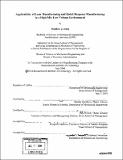Applicability of lean manufacturing and quick response manufacturing in a high-mix low-volume environment
Author(s)
Joing, Matthew J. (Matthew John), 1972-
DownloadFull printable version (6.787Mb)
Other Contributors
Leaders for Manufacturing Program.
Advisor
Stanley B. Gershwin and Roy E. Welsch.
Terms of use
Metadata
Show full item recordAbstract
As today's manufacturers face increasing pressure to improve costs and compete globally, many are turning to the philosophy of Lean Manufacturing as exemplified by the Toyota Production System. Lean is most successful when production is characterized by a few high-volume products, but may not be the answer as the production mix increases and volume decreases. This thesis focuses on this high-mix, low-volume type of production in addition to two other key production system characteristics: demand variability and degree of customization. A manufacturer's position along these four characteristics is very important to the applicability of Lean theory. The alternative philosophy of Quick Response Manufacturing (QRM) is compared to Lean and shown to offer a better fit in some cases. One such case where Lean does not fit neatly is circuit card assembly at Raytheon Systems Limited in Glenrothes, Scotland, where the author conducted his six-month LFM internship. Five steps towards manufacturing improvement are focused on in this thesis: choosing metrics, reorganizing the factory, selecting lot sizes, implementing a production control strategy, and deciding on a material presentation method. The recommended steps to improve circuit card assembly include ideas from both Lean and QRM. This mix of ideas was implemented at Raytheon before the end of the internship and resulted in marked improvement. On-time delivery and customer satisfaction dramatically improved while lead times and inventories dropped significantly. Using Lean Manufacturing as the sole guideline for improvement was not appropriate for this particular manufacturing system. The final takeaway from the internship and thesis is that there is no one-size-fits-all manufacturing philosophy.
Description
Thesis (M.B.A.)--Massachusetts Institute of Technology, Sloan School of Management; and, (S.M.)--Massachusetts Institute of Technology, Dept. of Mechanical Engineering; in conjunction with the Leaders for Manufacturing Program at MIT, 2004. Includes bibliographical references (p. 66).
Date issued
2004Department
Leaders for Manufacturing Program at MIT; Massachusetts Institute of Technology. Department of Mechanical Engineering; Sloan School of ManagementPublisher
Massachusetts Institute of Technology
Keywords
Sloan School of Management., Mechanical Engineering., Leaders for Manufacturing Program.